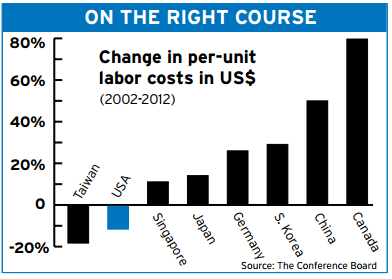U.S. Manufacturing Growing Steadily
Cheaper domestic energy, rising wages overseas and industries that use high-tech to make high-tech products are making producing goods on American soil attractive again.
U.S. manufacturing continues to step it up, with another solid gain in output this year—3.5% or better. Nearly five years after the Great Recession ended, it continues to outpace the rate of overall GDP growth. New business and goods-out-the-door are up. There’s more optimism and more hiring. For seven months in a row, the number of factory jobs has increased. By year-end, 100,000 more workers will be added to payrolls. There’s growth in every region of the country, and it’s cutting across a swath of industries.
Aviation manufacturers are sitting on a backlog of orders. With car and light-truck sales (including imports) likely to top 16 million this year, assembly lines will hum. Chemicals—everything from paint thinner to plastic resins—are expanding on cheaper petroleum. Pharmaceutical companies continue to chug ahead. Biotech is likely to see double-digit growth again in 2014. Gains in the U.S. for medical equipment are steady, and prospects of increased export sales are bright. Next-generation computer chips have semiconductor makers going strong. Even heavy equipment is thriving, with rising global demand for building, energy exploration and drilling equipment, and more.
The broad expansion is partly just the pendulum swing after recession cutbacks. (From 2008 to 2009, factory output fell 20% and 2 million workers were laid off.) But it also reflects some big shifts in the global business environment. First, the relative cost of producing on U.S. soil compared with overseas is declining. Productivity improvements—automation, etc.—are shearing per-unit labor costs here while rising wages elsewhere in the world shove them up. Domestic energy supplies are abundant, thanks to the fracking boom. And lower shipping expenses help as well.

Sign up for Kiplinger’s Free E-Newsletters
Profit and prosper with the best of expert advice on investing, taxes, retirement, personal finance and more - straight to your e-mail.
Profit and prosper with the best of expert advice - straight to your e-mail.

But a slew of less obvious cost benefits to operating in the U.S. are increasingly garnering recognition, too: Fewer worries about intellectual property and technology theft. More-timely delivery. Political stability. Legal and regulatory systems that are clearer and more easily navigated.
If you’re skeptical about how much value such intangibles have, consider these figures from a recent World Bank study on just one of the factors: the potential difference in settling a typical contract dispute over the sale of goods. In the U.S., that might take 370 days and cost 14% of the claim’s value to resolve. In East Asia, the same dispute would likely chew up 522 days and a whopping 49% of the claim’s value. In Latin America, the tally would be 727 days and 31% of the value. In South Asia, it would typically take three years to tie up. And the U.S. compares favorably even with other highly developed nations. There, resolution of such a dispute would typically require 510 days and cost the company 20% of the claim’s value in legal and other fees.
Another factor favoring the growth of U.S. manufacturing in the years ahead is the growing use of advanced technology and processing, an area in which the U.S. has a significant competitive advantage. Much basic manufacturing—making products such as glass, steel, textiles, apparel and furniture that require little processing—has fled the U.S. for lower-wage sites overseas.
With the exception of computers and electronics—the one advanced tech category that benefits from lower labor costs—industries requiring more sophisticated processing are more likely to stay put. They include aviation, automaking, biotechnology and industrial machinery. Indeed, 37% of U.S. manufactures and 45% of exported goods are advanced tech: Medicines and medical devices, power generation and transmission equipment, communications gear, navigational instruments, magnetic and optical media, etc. All told, such products account for nearly 5% of GDP. Add on related services, such as software design, and the total rises to about 13%. Over the next decade, those shares will climb even higher, even faster.
As a result, the long slide in manufacturing’s share of GDP may be ending. After dipping sharply during the Great Recession, it will approach 13% this year—roughly the same share as in 2004 to 2007. Look for factories’ share of employment, however, to continue to slide as automation, including robots, takes on a larger role.
Get Kiplinger Today newsletter — free
Profit and prosper with the best of Kiplinger's advice on investing, taxes, retirement, personal finance and much more. Delivered daily. Enter your email in the box and click Sign Me Up.

David is both staff economist and reporter for The Kiplinger Letter, overseeing Kiplinger forecasts for the U.S. and world economies. Previously, he was senior principal economist in the Center for Forecasting and Modeling at IHS/GlobalInsight, and an economist in the Chief Economist's Office of the U.S. Department of Commerce. David has co-written weekly reports on economic conditions since 1992, and has forecasted GDP and its components since 1995, beating the Blue Chip Indicators forecasts two-thirds of the time. David is a Certified Business Economist as recognized by the National Association for Business Economics. He has two master's degrees and is ABD in economics from the University of North Carolina at Chapel Hill.
-
 Stock Market Today: Great Power Affairs Mesmerize Markets
Stock Market Today: Great Power Affairs Mesmerize MarketsThe U.S. and China are at least talking about talking about tariffs, and investors, traders and speculators are showing a little less fear.
By David Dittman
-
 Is Walmart Plus Worth It?
Is Walmart Plus Worth It?There are tons of exciting Walmart Plus benefits – but are they worth the $98 annual fee?
By Rachael Green
-
 The Economic Impact of the US-China Trade War
The Economic Impact of the US-China Trade WarThe Letter The US-China trade war will impact US consumers and business. The decoupling process could be messy.
By David Payne
-
 AI Heads to Washington
AI Heads to WashingtonThe Kiplinger Letter There’s big opportunity for AI tools that analyze MRIs and other medical images. But also big challenges that clinicians and companies will have to overcome.
By John Miley
-
 The AI Doctor Coming to Read Your Test Results
The AI Doctor Coming to Read Your Test ResultsThe Kiplinger Letter There’s big opportunity for AI tools that analyze CAT scans, MRIs and other medical images. But there are also big challenges that human clinicians and tech companies will have to overcome.
By John Miley
-
 The New Space Age Takes Off
The New Space Age Takes OffThe Kiplinger Letter From fast broadband to SOS texting, space has never been more embedded in peoples’ lives. The future is even more exciting for rockets, satellites and emerging space tech.
By John Miley
-
 Rising AI Demand Stokes Undersea Investments
Rising AI Demand Stokes Undersea InvestmentsThe Kiplinger Letter As demand soars for AI, there’s a need to transport huge amounts of data across oceans. Tech giants have big plans for new submarine cables, including the longest ever.
By John Miley
-
 What DOGE is Doing Now
What DOGE is Doing NowThe Kiplinger Letter As Musk's DOGE pursues its ambitious agenda, uncertainty and legal challenges are mounting — causing frustration for Trump.
By Matthew Housiaux
-
 A Move Away From Free Trade
A Move Away From Free TradeThe Letter President Trump says long-term gain will be worth short-term pain, but the pain could be significant this year.
By David Payne
-
 Trump’s Whirlwind Month of Crypto Moves
Trump’s Whirlwind Month of Crypto MovesThe Kiplinger Letter The Trump administration wants to strengthen U.S. leadership in the cryptocurrency industry by providing regulatory clarity.
By Rodrigo Sermeño
